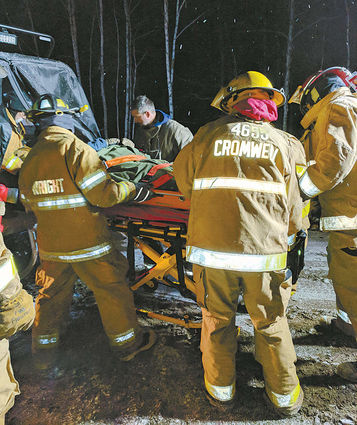Be ready for winter emergencies
November 30, 2018
Living at this latitude, we know how to dress for winter. Layers of woolens, an exterior casing of snow pants, heavy jacket, reliable boots with ample socks, a generous hat, a scarf to wrap around the neck, and gloves with inner warmth and outer resistance to the wet. But when we're out there hunting, on the snowmobile or ski trail, or flying across the lake on ice skates, are we prepared for the worst?
All kinds of setbacks are imaginable on the winter trails and lakes. Not to be alarmist, but being aware of the possibilities and your options can be lifesaving. Know ahead of time which hospital you'll want to be taken to if necessary.
Think ahead! Remember, it's you, and your loved ones and friends. Avoid fatalities and injuries by using common sense. Carry a toolkit, spare parts, flashlight, first aid kit, and survival items such as high-energy food, fire starting equipment and a compass.
Our community emergency responders, like Mike Peterson of the Cromwell-Wright Fire and Ambulance Service, offer advice on how to avoid catastrophe.
The first: "Know where you are!" Our cell phones work on some trails, but not all. The Rogers Lake ski trail, for instance, is close to a good cell tower. One time last year, lost far to the north of Rogers Lake, Ann could only figure out her location by loading up a Google Map and spotting the tiny Rogers Lake on it.
Keeping a good map with you can be a lifesaver. You can make your own ahead of time. Be mentally prepared - ask yourself the "what if?" question before you leave. If you're going alone, make sure someone knows where you are going, when you left, and when you expect to be back. If you're on ice, carry homemade handheld picks with you to pull yourself out. Carry a hand-operated winch with you in case you bog down in swamps - Rod Walli and Ann relied on one twice while late-fall trail-clearing on the Rogers Lake ski trail. Use snow and/or branches to free a snowmobile sinking into a bog incompletely frozen.
We can learn a lot from our EMTs. They're the ones who try to find you when you've called 911. A first "must" is knowing where you are. One of our EMTs received a call from a distressed snowmobiler who described his location as "near the birch tree and an evergreen." Skiers, snowmobilers and four-wheelers should be noting every junction they pass and be able to describe it. New logging roads may have obliterated or rerouted familiar trails. Keep mental rough estimates of the distances you've gone since the last sign or junction.
If you are sidelined or hurt: stop, sit, and collect your thoughts. You are not lost. You are right where you are. Your camp, vehicle and everyone else is lost! Think: "What physical and mental resources do I have that can help me in this predicament?" Take an inventory of your survival kit items and how you will use them. Above all, remain positive, "I will survive!" Observe: Look around for shelter, water, high ground, an open area where searchers can spot you? It will be easier for them if you stay in one place, build a fire and a makeshift shelter. Plan: Be positive and take care of yourself. If it's late in the day, build a fire for heat and signaling and find or make a shelter against the weather.
Every November, the Cromwell-Wright crew holds mock exercises staging an accident. They've learned about the challenges of off-road vehicle rescue: how to get their emergency vehicles into tight spots, avoid sinkholes, handle a gurney under challenging circumstances like water or snow drifts, or carry out the injured out by hand. One of us, Tina, played the role of the victim in this fall's training exercise. She acted nearly dead from a head-on snowmobile collision. She was surprised at the personal touches of the rescuers. They spoke to her in soothing tones. They wrapped her in a blanket which she found surprisingly warm.
The Cromwell-Wright Fire and Ambulance, like others in our county, has a dedicated crew of volunteers who train for this work and are willing to come out in any weather. The Snow Gophers Club, with 60 active members, convenes area snowmobilers every year. They own, caretake and rent out the old DNR forestry building just north of Cromwell. Members of a statewide organization, they contract for trails to be tracked and offer snowmobile safety instruction for kids.
Have fun. It is glorious out there. Thank safety. Start prepared and stay prepared. And save the alcohol for afterwards around a warm fire.
Tina Johnson is a Cromwell area resident, employee of Northview Bank, and avid snowmobiler. Ann Markusen is a retired professor who lives in Red Clover township and loves to cross-country ski and ice skate.







